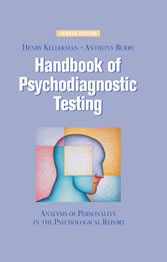Suchen und Finden
Service

Handbook of Psychodiagnostic Testing - Analysis of Personality in the Psychological Report
Henry Kellerman, Anthony Burry
Verlag Springer-Verlag, 2007
ISBN 9780387713700 , 202 Seiten
4. Auflage
Format PDF, OL
Kopierschutz Wasserzeichen
Preface
6
Acknowledgments
11
Contents
12
The Referral
15
What is a Psychological Test Report?
15
Clarity of the Report
16
Meaningfulness of the Report
16
Synthesis of the Final Report
17
Why a Psychological Report May be Requested
17
Context of the Referral
17
Focusing the Report
18
Summary
19
Sections of the Psychodiagnostic Report
20
Suggested Outline of Sections The Clinical Interview
21
Cognitive Organization and Reality Testing
22
Intellectual Functioning
22
The Nature of Anxiety
23
Impulse versus Control
24
Defensive Structure
25
Identity and Interpersonal Behavior
26
Diagnosis and Prognosis
28
Summary
29
The Clinical Interview
30
Meeting the Patient
30
Samples of Behavior
31
Samples versus Evidence
32
The Referral and the Clinical Interview
32
Diagnostic Formulations Based on the Clinical Interview
33
Autism
35
Affect
36
Ambivalence
39
Association
40
Orientation to Time, Place, and Person
41
Summary
43
Reality Testing and Cognitive Functioning
45
Assessing Reality Testing
45
Primary Autonomous Ego Function
46
Secondary Autonomous Ego Function
48
Summary
54
Reality Testing and Cognitive Functioning
55
Integrative Function of the Ego
55
Communicating Findings
56
The Regulatory Aspect in Relation to Underachievement
57
Synthetic Function of the Ego
59
Diagnostic Implications
59
Communicating Findings
61
Adaptive Function of the Ego
61
Summary
63
Intellectual Functioning
65
DSM-IV-TR and Traditional I.Q. Range
66
Intelligence Test Scales
67
Verbal and Performance I.Q.
69
Verbal Equals Performance
69
Verbal Greater than Performance
70
Performance Greater than Verbal
71
Implications of Verbal-Performance Discrepancy
73
Subdividing Groups of Verbal and Performance Subtests
73
Use and Implications of ÏAÓ and ÏBÓ Groupings
75
Summary
76
Intellectual Functioning
77
Estimating Potential Levels of Intellectual Functioning
77
Intrasubtest Scatter
78
Quality of Responses
79
Pro-Rated I.Q.
79
Analysis of Subtest Scatter
80
Verbal Subtests (Wechsler Scales)
81
Performance Subtests (Wechsler Scales)
83
Conclusion
85
Summary
87
The Nature of Anxiety
88
Anxiety as a Central Focus in the Report
88
What does the Term Anxiety Mean?
89
The PatientÌs Experience of Anxiety
89
The Central Role of Anxiety in the Psychodiagnostic Evaluation
90
Is the Anxiety Consciously Experienced?
91
Is the Anxiety Acted-Out?
92
Is the Anxiety Somatized?
95
Is the Anxiety Understood by the Patient?
97
Sources of Anxiety in the Personality
97
Summary
99
Impulse Versus Control
100
The Interplay Between Impulses and Controls
100
Dimensions in the Analysis of Impulses and Controls
101
The Nature of Impulses
102
Impulse and Action Orientation
102
Impulse and Cognition
103
Types of Impulses Anger
104
Sexuality
106
Summary
108
Impulse Versus Control
109
Control Mechanisms Cognitive Controls
110
Ego Controls
110
Defense Mechanisms as Controls
111
Character Traits as Controls
112
Fantasy as Control
113
Fear as Control
114
Maturation: An Index of Impulse Versus Control
115
Immature: Impulse Dominated
115
Immature: Control Dominated
116
Mature Balance of Impulse and Controls
117
Summary
119
Defensive Structure
120
Individual Defense Mechanisms
121
Defenses Used to Manage Individual Emotions
123
Defenses and Character- or Personality-Trait Formation
125
Defenses Forming Character Trait Patterns
126
Defenses and the Report
127
Summary
131
Interpersonal Behavior
132
The Bridge Between Intrapersonal and Interpersonal Functioning
132
Conflict Stages and Derivative Behaviors
133
Oral-Dependent Conflict
133
Anal-Control Conflict
134
Phallic-Assertion Conflict
136
Oedipal-Competitive Conflict
137
Summary
140
Interpersonal Behavior
141
Emotion-Controlled Types Obsessive- Compulsive Personality
143
Paranoid Personality
144
Schizoid Personality
145
Emotion-Dyscontrolled Types Histrionic Personality
145
Narcissistic Personality
146
Antisocial or Psychopathic Personality
147
Emotion-Attached (Dependent) Types Dependent Personality
147
Passive-Aggressive Personality
148
Inadequate Personality
149
Emotion-Detached (Avoidant) Types Borderline Personality
149
Schizotypal Personality
150
Avoidant Personality
151
Summary
153
Diagnosis and Prognosis
154
Elements of Diagnosis
154
Diagnosis as a Shifting Phenomenon
155
Connections Between Diagnosis and the Presenting Problem
155
Acute Versus Chronic Pathology
156
Levels of Diagnosis
157
Integrating Diagnostic Levels
158
The Pathological Context and Diagnosis
159
Summary
161
Diagnosis and Prognosis
162
DSM-IV and DSM- IV-TR: The Diagnostic and Statistical Manual
162
Diagnostic Axes in DSM-IV and DSM-IV-TR
163
Definitions of Generally Used Diagnostic Terms Neurotic Disorders
165
Organic Impairment Disorders
172
The Psychoses
173
Nonpsychotic Mood Disorders
178
Prognosis
179
Summary
180
Intelligence Test Reports for Counselors, Teachers, and Parents, and Testing of Preschoolers
181
The Intelligence Test Referral
182
Identifying Data
183
Behavioral Observations
183
Test Results
184
Summary and Conclusions Section
187
Language in the Intelligence Test Report
188
Testing of Preschool Children
189
Summary
191
CODA
192
Resolving the Role-Anxiety Dilemma
193
The SupervisorÌs Role
193
The Active-Passive Dilemma
195
Appreciating Limits
196
Recommended Readings
198
Clinical Applications of Psychological Tests
198
The Clinical Interview
199
Reality Testing and Cognitive Functioning
199
Intellectual Functioning
199
Anxiety, Impluse, and Defensive Structure
200
Interpersonal Behavior and Character Structure
200
Diagnosis
200
Report Construction
201
Index
202














